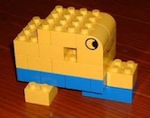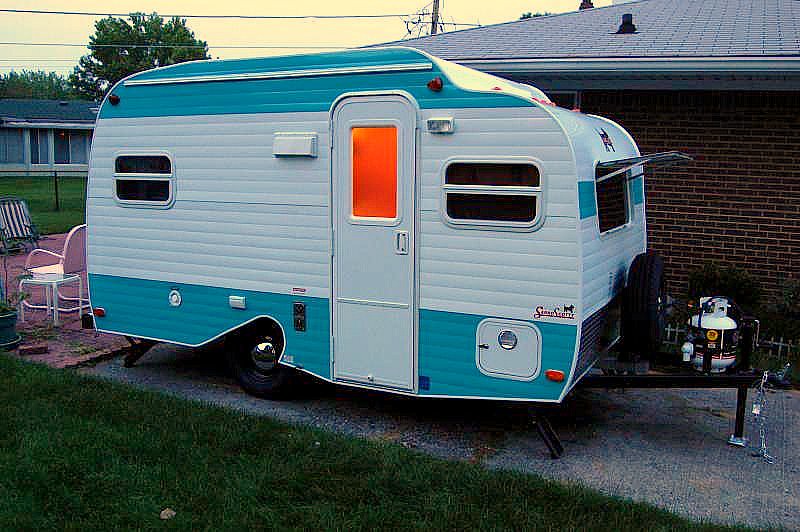I've been playing around with weights in some spreadsheets. For the two inch thick walls I've been designing into my popup designs. Wood borders and glued together like Elddis (ELDDIS) is doing on their caravans is a bit heavier than using the Aluminum Perimeter Frame (APF) I had come up with before. It all comes down to the SIP's wood borders vs. the APF. For the Elddis construction method each SIP panel needs a full wood border. For my APF design the SIPs only have foam at the edge unless something needs to be mounted there and can't be mounted to the frame. Otherwise wood blocking would be placed into the SIP panels at the same spots.
It is interesting to note that for a 1" thick wall, the ELDDIS method is close in weight to the APF method. The APF method doesn't change in weight with different wall thicknesses, while the ELDDIS method doubles in weight from 1" to 2" thick walls.
As an example of the weight difference I'll use the top left edge joint between the 2 inch thick wall, and the 3 inch thick roof. The ELDDIS method uses three pieces of wood. The Border piece on the side wall, which in my design has a 2" x 2" cross section, and the border piece on the roof, has a 2" x 3" cross section. There is also a key piece, but I won't count it's weight as it is placed into groves routed into the other two pieces of wood so it adds only the slight additional weight due to it being made out of Baltic birch plywood versus pine. The piece of wood at the top of the wall weighs 10.7 lbs, and the piece at the side of the roof weighs 15.9 lbs. For the APF there is the exterior frame piece which weighs 7.2 lbs, and the interior piece that weighs 5 lbs. So that gives an effective weight of 26.6 lbs for ELDDIS and 12.2 lbs for APF. In both designs the roof is 3" thick, and the side wall is 2" thick. The border wood is 2" wide and the thickness of the wall or roof. The APF is made from 0.100" thick aluminum sheet bent into a 2" angle for the inside corners, and for the outside piece a 2" radius corner round flanked by 2" wide gluing areas. The sizes of the trailers are the same, and so are all other construction details.
Construction wise, I think the ELDDIS method is maybe a bit easier. What you gain from not having to do metal fabrication and welding, you loose in having to make moderately more complex SIP panels. Both designs use gluing for holding the SIPs in place. There are things that can be done to lighten the wood borders used in the ELDDIS SIPs. Lightening holes can be bored into them, then filled with foam. Care would be needed to be taken that enough structural strength is left in the glue joint and wood, but there is plenty of excess strength there.
As a side note: Using oak edge boards is 66% heavier than pine. Laminating up Baltic birch plywood for them ends up being around 33% heavier than pine.
What does this mean to me. Well, I was hoping to save some weight. It didn't work out, but The ELDDIS method does negate the need for large metal working equipment so that does help give it some edge over the APF method even though it adds a couple hundred pounds to the weight of the hard sided pop-up TTT. I'll be looking into ways of lightening the perimeter wood frames, but still may not use them as any of them would require much more labor time to implement. There are some spots where major amounts of lightening could be done. The top edge of my base walls doesn't need to be solid. There isn't a mating glue joint edge there so I don't need a solid block there. Same goes for the top and bottom edges of the middle walls, and the bottom edges of the top's walls. They all could be narrowed to 1" wide instead of 2". That should save allot of weight.
My weight calculations are telling me that my 7' tall, by 5' 6" wide, by 12' long interior size hard sided pop up TTT will weigh around 300 lbs more because of the hard sided pop up feature, but it will have much much less than half the towing resistance because it will mostly sit in the hole punched by the tow vehicle. All in all it is looking like a 3,000 lbs towing weight with full fuel and water on board with 400lbs allowance for personal gear like clothing and food. I threw into the "base" weight the weights for two 40# propane tanks, 20 gallons fresh water in a tank, RV appliances, a couple spare tires, 210 Watt solar system, a portable generator, couple full 20L cans of gas, lawn chairs, etc.. Yeah, I loaded it down with allot of optional gear.

Got to be prepared...

But that also allows me to plan for it's possible inclusion later on.
Elddis video that has been linked to before:
http://www.caravantimes.co.uk/video/industry/video-what-makes-elddis-solid-construction-a-revolution-in-caravan-building--$21381771.htm Part way through they show an animated diagram of how the ELDDIS SIP panels are joined and what the joint looks like.
The APF corner detail, but with only 1" thick SIP panel walls instead of the 2" I'm now using.









 ... and it’s just an excuse to do more SHOPPING...
... and it’s just an excuse to do more SHOPPING... 
 But that also allows me to plan for it's possible inclusion later on.
But that also allows me to plan for it's possible inclusion later on.
